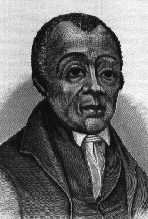|
Predominantly black churches date back to the last part of the 1700s. These congregations exist as part of standard denominations but they usually met separately. Only a few significant denominations existed for blacks prior to the Civil War. The Africa You should note that all these groups form in the north. Most American blacks reside in the south. In the south, whites usually refused to allow blacks to meet separately. In some areas blacks couldn't even assemble for worship. In areas where blacks do worship they worship with whites. The church at Cane Ridge, for example, build a balcony and blacks climbed a ladder to it from outside. I. The growth of black denominations. Most black denominations began after the Civil War. By 1860, about 11%, or 500,000, of America's 4,400,000 blacks belonged to churches. Methodist churches for blacks multiplied before and during the Civil War. They continued to grow after the war ended. The African Methodist Episcopal and the African Methodist Zion churches organized congregations throughout the south even while war raged. The Colored Methodist Church began about 1870. Northern Methodists allowed blacks to form their own conferences but patronized them. That is, northern whites kept a watchful eye and exercise continual guidance over the black conferences. Southern blacks attended Presbyterian churches prior to the war because their owners did. After the Civil War black membership in Presbyterian churches dropped dramatically--from 31,000 to only about 1,700. The Cumberland Presbyterians did not allow the formation of separate black congregations until after 1874. That year blacks formed the Colored Cumberland Presbyterian Church. Significantly other Presbyterian bodies see no corresponding black churches. Blacks felt uncomfortable in white churches and left. Most American blacks joined some sort of Baptist church. Black Baptists, however, worshiped with their white brethren for many years before forming their own congregations. Virginia blacks established a separate black Baptist church by 1867. This group became the National Baptist Convention in the U.S.A., Inc. Black conventions began multiplying rapidly after that. Americans soon hear of the National Baptist Convention, a Progressive National Baptist Convention and the National Primitive Baptist Convention of the U.S.A. It seems Baptists are always Baptists. Baptists often split to start new churches. All black Baptist organizations contain about 90% of American blacks claiming Christianity. Blacks generally stayed away from Catholicism until after the Civil War. Black Catholicism has grown steadily since the war. There are now about 500,000 black Catholics in the United States. Of the 176,000 nuns in the United States only 900 of them are black. II. Evaluation of the Black Churches Black churches express themselves emotionally and fervently. Black theology tends to be simplistic but is preached hot and straight. Preachers emphasize sin and salvation by grace. Black preachers use a dramatic style with tremendous use of a "sing song" delivery. Black music uses rhythm and movement. Worshipers are responsive, for the most part, and real feed back or interchange occurs between the preacher and the audience. Services in even the most liberal black Baptist churches have a charismatic flavor. Over the years black churches faced some serious shortcomings. William Warren Sweet, a historian of the 1930s, said there was more amusement than worship in black churches. He also noted lax moral conduct existing in black churches of the period. Furthermore, he argued, black churches often became political stepping stones for aspiring black leadership. Some of the best known contemporary black leaders of all political persuasions thrust themselves into the limelight after ministries: Jesse Jackson, Adam Clayton Powell and Martin Luther King Jr. to name three. These three, in particular, represented liberal and social thinking rather than conservative and evangelical. Black churches offered hotbeds of cultism as well. I think some of this results from the movement of blacks to urban centers. Like whites, they too found themselves far removed from their rural roots. Ira Reid, writing in 1927, gave an analysis of black cult leaders of his day in his book, Let us Prey. In recent history, other black cult leaders have emerged: Father Divine, who r These cult movements appeal to the frustrations of those living in the inner cities. Jim Jones appealed to pov Many black religious leaders focused on social issues. For many years the Southern Christian Leadership Conference led the struggle for black civil rights and social change. Their "Christian" work focused more on a political agenda than evangelism and the biblical Gospel. Of course the 1950s and 1960s saw much social unrest because of civil rights legislation and the effort to end segregation. During that period many blacks concluded the white Christian community was unredeemable. Malcolm X and other black protest leaders abandoned Christianity for Islam thinking it better suited to meeting their social goals. Contemporary sociologists suggest black religion helps develop community identity. They contend that the black feels alienated from the "real world." While much of this is changing, the typical black of the 50s and 60s enjoyed little political clout. Blacks often turned to religion to relieve the frustration they experienced. Observers note the black religious community is tremendously disunited; only their common search for identity holds them together. To their shame, the white conservative evangelical Christians neglected America's blacks. In fact, conservative Christians largely ignore the inner city. If it weren't for the Salvation Army and a few other "mission" efforts, poor city blacks or whites would barely know the Gospel. In the 50s and 60s, radical elements of democratic socialism did work in the cities. Some blacks continue to work through radical organizations. Others adopted Liberation Theology. Over the past few years blacks have emerged from the inner city to make their mark. Some climbed out on their own merit using their intelligence, athletic ability and entrepreneurial skills to better their existence. Some chose the military as a means to guarantee an education and/or the opportunity to learn marketable skills. While opportunities for blacks continue to widen, some think they aren't increasingly rapidly enough. For successful Christian work to begin in the inner city, there must be a willingness to understand the black culture and frame of reference. Work in such surroundings must be seen as "cross cultural" evangelism, for in truth it is. Most whites, even poor whites, cannot understand the "ghetto's" poverty and hopelessness. |
 n Methodist Episcopal Church, for example, grew out of the segregated ST. George Methodist Church in Philadelphia in 1793. Richard Allen led the withdrawn group to form themselves as a separate Methodist denomination the same year. In New York, members withdrew from the Johnstown Methodist Church to form the Zion Church in 1801. In 1821 blacks formed the African Methodist Episcopal Church.
n Methodist Episcopal Church, for example, grew out of the segregated ST. George Methodist Church in Philadelphia in 1793. Richard Allen led the withdrawn group to form themselves as a separate Methodist denomination the same year. In New York, members withdrew from the Johnstown Methodist Church to form the Zion Church in 1801. In 1821 blacks formed the African Methodist Episcopal Church. eferred to himself as "God incarnate"; Sweet Daddy Grace, who once said he was mightier than God. Grace maintained that if you sinned against God, grace can forgive you; but if you sin against Grace, God can't forgive you! Reverend Ike, who graduated from Manhattan Christian College, represents an early form of the "health and wealth" gospel. Ike maintained God wants his people rich! His lifestyle demonstrated it, too. Another cult leader is, believe it or not, Brother Leroy Jenkins of Ohio who formed The Church of What's Happening Now. Comedian Flip Wilson often parodied Jenkins in a skit. The epitome of black cultism is the Disciples of Christ preacher, the Reverend Jim Jones. Although white, Jones first attracted blacks and whites alike in an Indianapolis ministry. In time his group became almost completely black. Jones founded the ill fated Jonestown community in Guyana where more than 1,000 followers committed suicide.
eferred to himself as "God incarnate"; Sweet Daddy Grace, who once said he was mightier than God. Grace maintained that if you sinned against God, grace can forgive you; but if you sin against Grace, God can't forgive you! Reverend Ike, who graduated from Manhattan Christian College, represents an early form of the "health and wealth" gospel. Ike maintained God wants his people rich! His lifestyle demonstrated it, too. Another cult leader is, believe it or not, Brother Leroy Jenkins of Ohio who formed The Church of What's Happening Now. Comedian Flip Wilson often parodied Jenkins in a skit. The epitome of black cultism is the Disciples of Christ preacher, the Reverend Jim Jones. Although white, Jones first attracted blacks and whites alike in an Indianapolis ministry. In time his group became almost completely black. Jones founded the ill fated Jonestown community in Guyana where more than 1,000 followers committed suicide. erty stricken blacks of the Indianapolis area first. His socialistic program led them to follow him to San Francisco where he established a "Christian" commune known as "The Peoples' Temple." [Note: There are a number of interesting web sites regarding this cult such as "The Jonestown Re-enactment" and the that sponsored by Religious Tolerance.org.]
erty stricken blacks of the Indianapolis area first. His socialistic program led them to follow him to San Francisco where he established a "Christian" commune known as "The Peoples' Temple." [Note: There are a number of interesting web sites regarding this cult such as "The Jonestown Re-enactment" and the that sponsored by Religious Tolerance.org.]